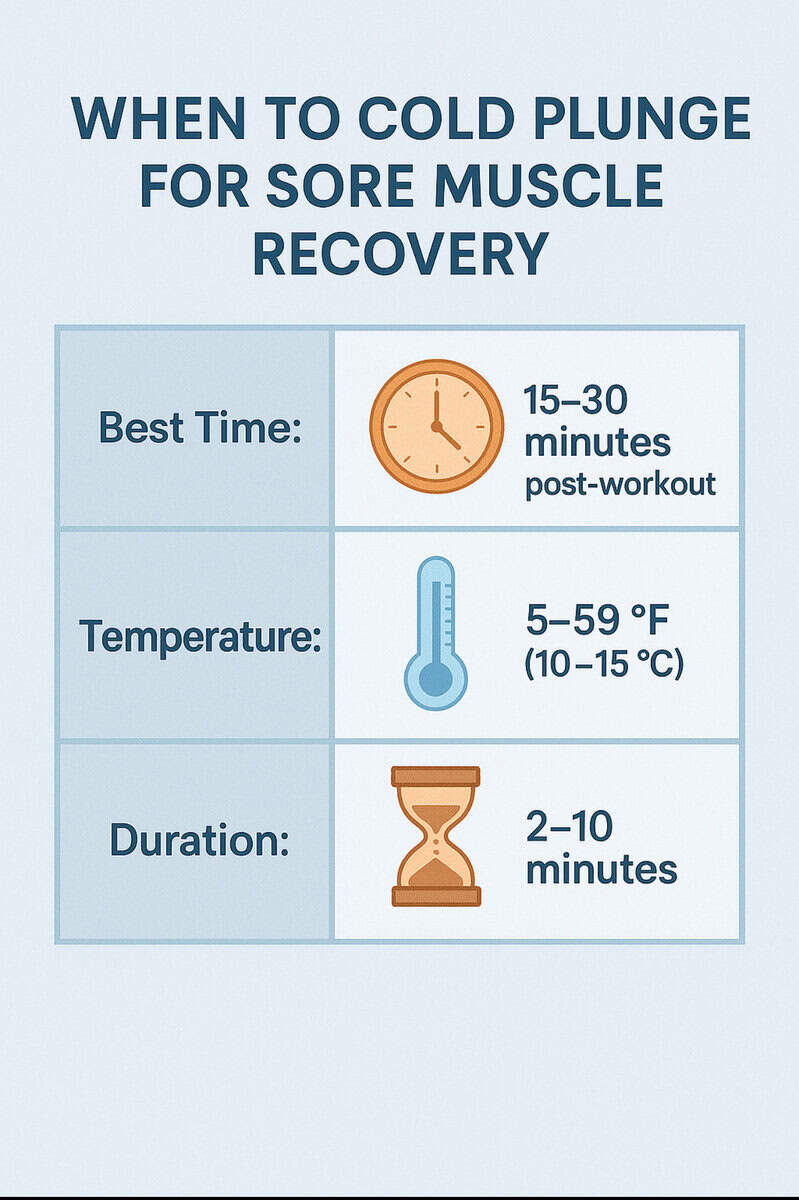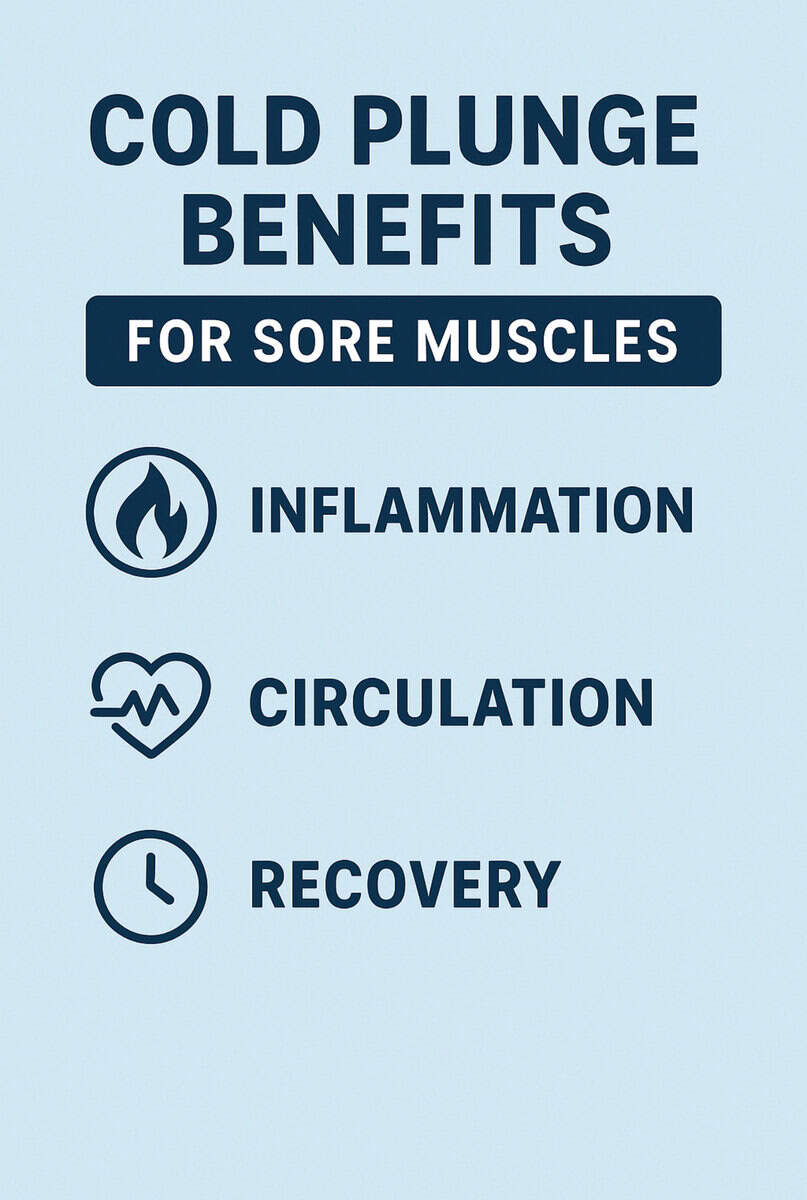Cold Plunge for Sore Muscles: Natural Relief That Works

💪 If you’re waking up sore after a tough workout or struggling with lingering muscle aches, you’re not alone. Many athletes and wellness seekers are turning to cold plunge therapy for sore muscles — and the science is backing it up. 🌡️❄️
Cold plunging can reduce inflammation, numb pain, speed up recovery, and even enhance performance when used consistently. Whether you’re lifting heavy at the gym or battling DOMS (Delayed Onset Muscle Soreness), a quick dip in icy water might be your best post-workout weapon. 🏋️♀️
In this guide, we’ll break down how cold plunge therapy works for muscle recovery, the best practices, and how to get started safely — all based on evidence-backed wellness strategies.
🔍 How Cold Plunges Help Sore Muscles Heal

Muscle soreness, especially the kind that hits 24–72 hours after intense activity, is usually caused by micro-tears in muscle fibers. These tears trigger inflammation — your body’s natural healing response. While some inflammation is good, too much can slow you down. 😓
Cold water immersion constricts blood vessels, reducing blood flow to the area and minimizing swelling. After you exit the cold, your blood vessels dilate, increasing circulation and flushing out waste products like lactic acid. This creates a “pump and flush” effect that helps muscles recover faster. 🧬🚿
📚 Studies have shown that cold water immersion can significantly reduce muscle soreness post-exercise[1], especially when used within two hours of intense physical activity.
⚖️ Cold Plunge vs Foam Rolling, Massage, and Sauna
While foam rolling and stretching are great for mobility, they don’t address inflammation as directly as cold plunging. Here’s how a cold plunge for sore muscles compares to other methods:
- 🧊 Cold Plunge: Targets inflammation, pain relief, and circulation in under 5 minutes
- 🧽 Foam Rolling: Best for releasing tight fascia and improving flexibility
- 💆 Massage Therapy: Excellent for relaxation and muscle knots, but cost and time can be barriers
- 🔥 Infrared Sauna: Improves circulation and reduces stiffness, ideal for long-term recovery
When paired together, contrast therapy — alternating hot and cold — can amplify the benefits of both. We recommend checking out our Buyer’s Guide for tubs that support both cold and heat modes. 🛁

📅 Timing Your Cold Plunge for Maximum Relief
⏱️ The best time to cold plunge for sore muscles is within 30 to 120 minutes post-workout. This is the window when your muscles are inflamed, and cold therapy can help blunt that response without interfering too much with adaptive growth.
For general recovery and ongoing soreness:
- 🧊 Duration: 2 to 5 minutes
- ❄️ Temperature: 50–59°F (10–15°C) is ideal
- 🔁 Frequency: 3–4x per week for athletes; 1–2x for general wellness
Note: Going below 50°F may cause shivering and excessive stress on the body. It’s not always better to go colder. Stick to a comfortable cold range unless you’re building tolerance intentionally.
Looking for full guidance? Our benefits guide outlines the top reasons to plunge regularly and how to stay safe. ✅

🏆 Top Cold Plunge Tubs for Sore Muscle Relief

Ready to bring the benefits of cold therapy home? These cold plunge tubs are ideal for athletes and fitness lovers who want fast recovery without hassle:
• Built-in cooling system (no ice needed)
• Plug-and-plunge setup
• Sleek design, minimal upkeep
🔗 View The Plunge →
• Handcrafted in the USA
• Whisper-quiet operation
• Holds steady temps in all seasons
🔗 Explore Renu Therapy →
• Portable and collapsible
• Great for small spaces or travel
• Ice-based system, no chiller
🔗 Check Edge Tub Deals →
Reach out via our Contact Page for personalized advice, or check our full 2025 Buyer’s Guide for reviews, pricing, and features.
🚫 Safety Tips and Contraindications

While a cold plunge for sore muscles is safe for most healthy adults, certain individuals should use caution or avoid it altogether. Always consult your healthcare provider if you have medical conditions.
Avoid cold plunges if you:
- 🫀 Have cardiovascular disease or high blood pressure
- 🤰 Are pregnant or trying to conceive
- ⚡ Have a history of seizures or fainting
- ❌ Are extremely sensitive to cold or have Raynaud’s disease
❄️ Always warm up gradually afterward and monitor for numbness or dizziness. Learn more in our full cold plunge benefits and safety guide.
🧘 Final Thoughts: Can Cold Plunge Really Help Sore Muscles?
✅ In short: yes, it can. Cold plunge therapy is one of the most effective natural tools for managing sore muscles and reducing inflammation — backed by both research and real-world results.
Whether you’re an athlete or just love staying active, adding cold water immersion to your recovery routine can help you feel better, faster.
👉 Want to learn more? Browse our full blog index for expert articles, or get in touch with our team for personalized recommendations.
🧦 Add Compression for Faster Muscle Relief
Want to boost the benefits of your cold plunge for sore muscles? Try combining it with compression garments or wraps immediately afterward. 💡
Cold plunging reduces inflammation, and compression helps maintain proper blood flow and minimize fluid buildup. This combination is especially helpful for:
- 🏃 Runners dealing with quad and calf soreness
- 🏋️ Lifters with tight shoulders or arms
- 🧍♂️ Anyone recovering from a long day on their feet
Just make sure you warm up gently before compressing the area too tightly.
🔥➡️❄️ Contrast Therapy for Next-Level Muscle Recovery
Contrast therapy involves alternating between hot and cold treatments, and it’s a favorite among athletes for post-exercise muscle recovery. 🧖♂️➡️🧊
Here’s a sample protocol:
- 🔴 Start with heat: Use an infrared sauna or hot shower for 10–15 minutes
- 🔵 Cold plunge: 2–5 minutes at 50–59°F
- 🔁 Repeat 2–3 rounds
This cycle improves vascular elasticity, pain relief, and circulation — a great option for heavy leg days or HIIT sessions. Learn more in our guide comparing plunge vs sauna benefits.
👥 Best Use Cases for Cold Plunge Muscle Relief
A cold plunge for sore muscles isn’t just for elite athletes. Here’s who can benefit the most:
- 🏋️♀️ Gym-goers: Post-leg day relief, DOMS control, recovery days
- 🚴♂️ Endurance athletes: Lower body recovery after long runs or rides
- 🧘♀️ Wellness seekers: Low-impact cold therapy to complement yoga or sauna use
- 🎾 Weekend warriors: Occasional relief from recreational soreness
Want more personalized advice? Contact us and we’ll help you build a recovery plan around your lifestyle. 💬

❓ Common Questions About Cold Plunge and Muscle Recovery
How soon after a workout should I cold plunge?
Within 30 to 120 minutes is ideal. This is when inflammation peaks and the plunge will be most effective.
Is it safe to cold plunge every day?
Yes, for most healthy individuals. Just keep sessions short and avoid overexposure below 50°F.
Will cold plunge blunt muscle gains?
If you’re strength training for hypertrophy, cold plunging immediately after may slightly reduce muscle growth. For general soreness and recovery, it’s extremely helpful.
Do I need a fancy cold plunge tub?
Not necessarily! Many start with DIY setups like ice barrels or portable tubs. For long-term use, we recommend investing in a filtered, temperature-controlled model — see our top picks here.






